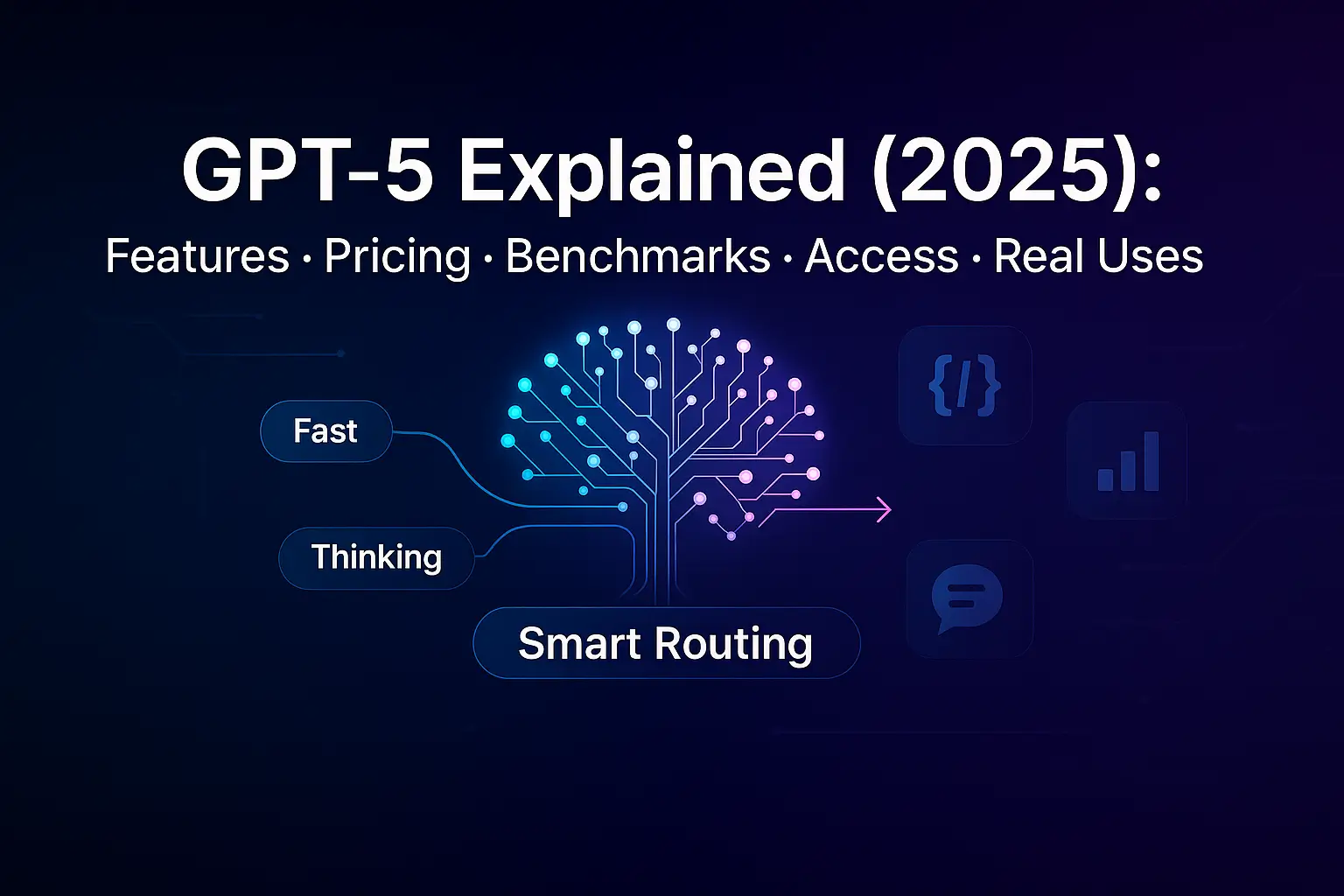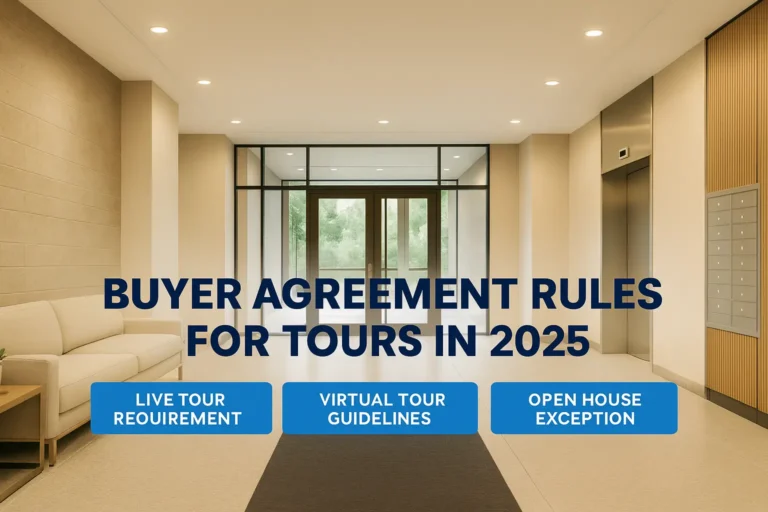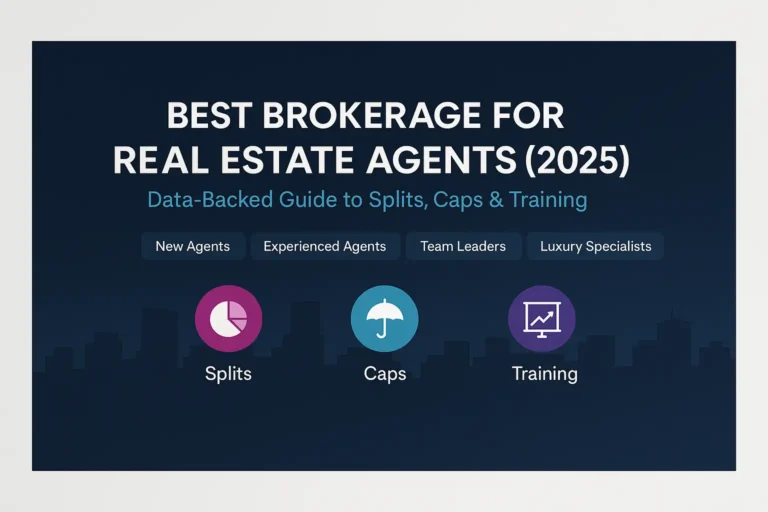GPT-5 Explained 2025: Features, Pricing, Benchmarks, Access, and Real Uses
Updated: August 9, 2025
GPT-5 is officially here. It’s OpenAI’s smartest, fastest, most useful model so far, with built-in thinking and a unified experience that decides when to respond quickly and when to think longer. It sets new marks on math, coding and health benchmarks, and it’s rolling out as the default in ChatGPT for logged-in users, with API access for developers.
But what does this actually mean for your daily work, your business processes, and the competitive landscape? Let me walk you through everything you need to know about GPT-5, from verified capabilities to practical implementation strategies that can give you an edge right now.
Quick Model Comparison: Find the Right GPT-5 for Your Needs
How GPT-5’s Smart Routing Works
ChatGPT uses a real-time router to send easy queries to a fast model (gpt-5-main) and tough ones to a deeper gpt-5-thinking path. If you need extra rigor, say “think longer” or pick GPT-5 Thinking.
What this means for you is simple: no more guessing which AI model to use, no more switching between different tools, and no more compromising between speed and intelligence.
The Numbers That Matter: GPT-5’s Performance Breakthrough
Let’s talk about performance because the benchmarks are genuinely impressive. GPT-5 achieved 94.6% on AIME 2025 mathematics problems without using any tools, which puts it at PhD-level mathematical reasoning. In coding, it scored 74.9% on SWE-bench Verified and 88% on Aider Polyglot, establishing new standards for AI-assisted software development.
But here’s the number that really caught my attention: GPT-5 scored 46.2% on HealthBench Hard while GPT-4o scored 0%. This represents a quantum leap in AI’s ability to handle health-related questions and medical information synthesis.
These aren’t just academic exercises. These benchmarks translate directly into real-world capabilities that can transform how you work, whether you’re a developer, researcher, healthcare professional, or business leader.
What Actually Changed: The Major Improvements Over GPT-4
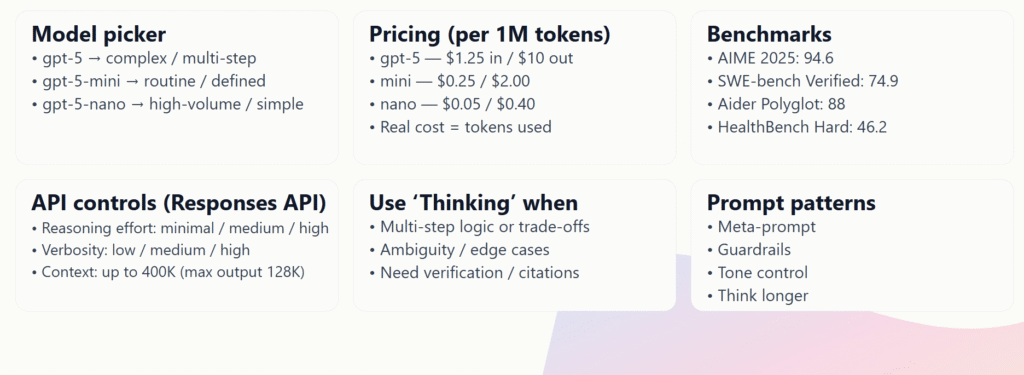
GPT-5 reduces hallucinations, improves instruction-following and writing, boosts coding, and introduces safe-completions that aim to stay helpful within policy. The API exposes reasoning effort and verbosity controls, plus a 400K context window (up to 128K output).
Here are the key improvements:
- Fewer Hallucinations: Significantly reduced factual errors and improved reliability
- Better Instruction Following: More precise adherence to specific requests and constraints
- Improved Writing Quality: Enhanced coherence, style, and contextual appropriateness
- Superior Coding Performance: Advanced programming capabilities and debugging
- Enhanced Health Responses: Better medical and health-related information synthesis
- Safe Completions: Replaces hard refusal system with helpful responses within safety boundaries
The GPT-5 Model Family: Choosing the Right Tool
Understanding the different GPT-5 variants is crucial for getting the best value and performance:
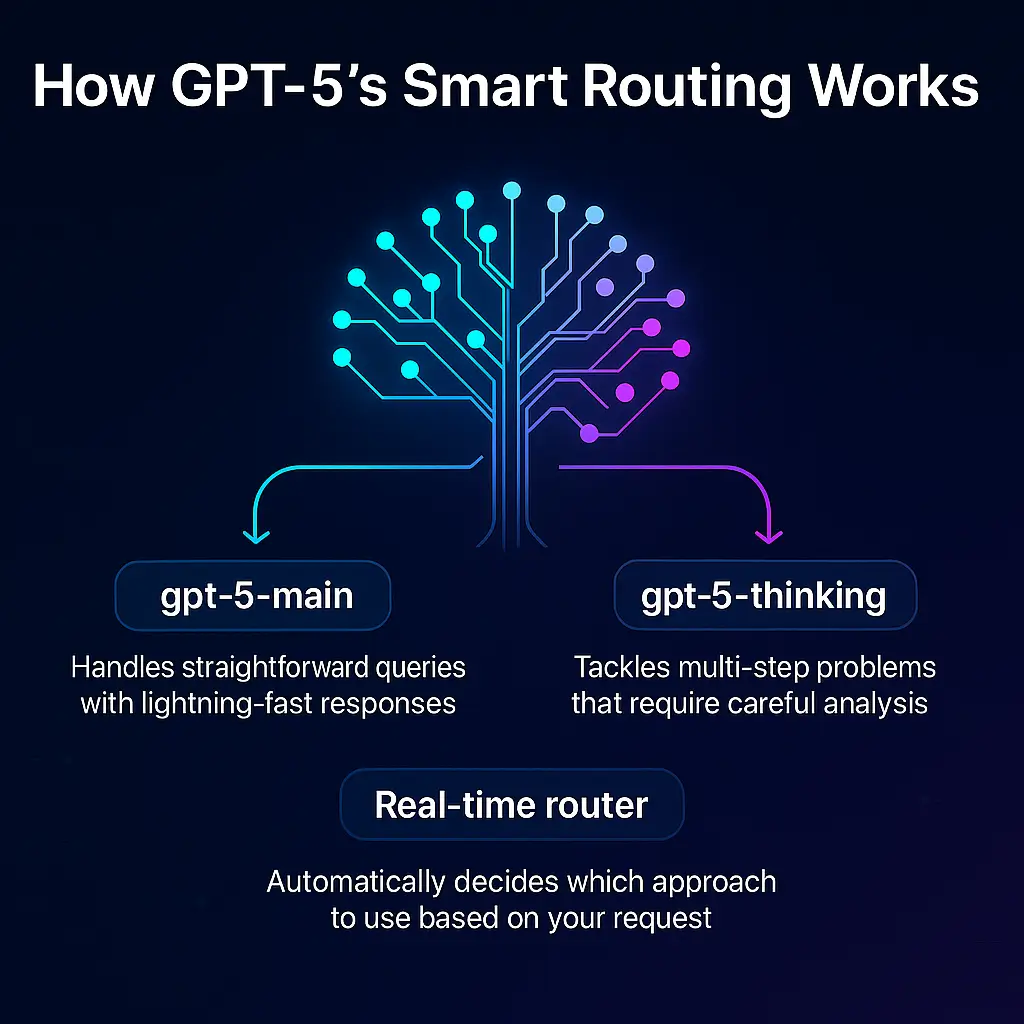
GPT-5 (Full Model)
Best for: Complex reasoning, comprehensive world knowledge, multi-step tasks Pricing: $1.25 per million input tokens, $10 per million output tokens Context: 400,000 context window with max output 128,000 tokens When to use: Financial analysis, research projects, strategic planning
GPT-5 Mini
Best for: Balanced performance at lower cost Pricing: $0.25 per million input tokens, $2.00 per million output tokens When to use: Daily business tasks, content creation, customer support
GPT-5 Nano
Best for: High-throughput, simple tasks Pricing: $0.05 per million input tokens, $0.40 per million output tokens When to use: Data classification, batch processing, simple automation
GPT-5 Chat Latest
Best for: General chat without reasoning overhead Pricing: Same as GPT-5 full model When to use: Conversational applications where reasoning isn’t needed
Current Challenges and Practical Solutions
Router Switching Issues
Early users reported problems with GPT-5’s automatic routing system not engaging deeper reasoning when expected. OpenAI CEO Sam Altman acknowledged these issues, explaining that router problems made GPT-5 appear less intelligent than it actually is.
Solution: OpenAI is implementing fixes and considering manual toggle options. In the meantime, use explicit phrases like “think carefully about this” to trigger deeper reasoning.
Creative Writing Considerations
While GPT-5 excels at technical tasks, some users find it more cautious and structured for purely creative endeavors compared to previous models.
Solution: Use specific creative prompts and consider combining GPT-5 with other tools for maximum creative output. Frame creative tasks clearly to help the model understand you want imaginative, not just accurate, responses.
Token Budget Management
GPT-5 tends to use entire token allowances, sometimes failing to complete tasks due to limits rather than capability constraints. About 30% of task failures result from token exhaustion rather than inability.
Solution: Implement better token management by breaking complex tasks into smaller parts and using appropriate model variants for different complexity levels.
How to Try GPT-5 Right Now
ChatGPT: Rolling out broadly as the new default; choose GPT-5 Thinking when you want deeper analysis.
API: Use models gpt-5, gpt-5-mini, gpt-5-nano via the Responses API. The new official parameters include reasoning effort control and verbosity control for fine-tuning responses.
Best Practices for Maximum Performance
1. Leverage the Router System Effectively
- Use phrases like “analyze this thoroughly” to trigger deeper reasoning
- Keep simple queries direct for faster responses
- Trust the automatic routing for most tasks
2. Optimize Your Prompts The most effective approach is using GPT-5 as a “meta-prompter.” Try this format:
“Here’s my prompt: [YOUR PROMPT]. I want it to [DESIRED BEHAVIOR], but instead it [CURRENT BEHAVIOR]. What minimal changes would improve consistency?”
3. Control Response Detail and Reasoning
- Use verbosity settings (low/medium/high) – these are official API parameters
- Set reasoning effort from minimal to high based on task complexity – also an official parameter
- Implement clear boundaries to prevent unnecessary exploration
4. Structure Complex Tasks
- Break multi-step processes into separate conversations for optimal performance
- Use persistence prompts: “continue until completely resolved”
- Provide clear success criteria and define acceptable actions
Business Applications That Create Real Value
Healthcare Transformation
GPT-5’s 46.2% HealthBench score positions it as a powerful medical assistant. Healthcare organizations can leverage GPT-5 for:
- Patient data analysis and preliminary assessments
- Medical literature synthesis for research support
- Clinical documentation automation
- Treatment plan recommendations (with appropriate oversight)
Software Development Revolution
With its 74.9% SWE-bench performance, GPT-5 is reshaping development workflows:
- Complete application generation from simple descriptions
- Legacy code refactoring and technical debt reduction
- Automated testing and documentation generation
- Code review and optimization suggestions
Financial Services Enhancement
GPT-5 enables sophisticated financial analysis:
- Automated due diligence for transactions
- Complex scenario modeling for risk assessment
- Regulatory compliance document analysis
- Investment research and market analysis
Real Estate Mini Guide: GPT-5 Applications for Property Professionals
Specialized use cases for real estate agents, brokers, and property managers
📝 Listing Descriptions with Tone Controls Generate compelling property descriptions that match your brand voice and target demographic. GPT-5’s improved instruction following means better adherence to specific tone requirements and feature highlighting.
Sample prompt: “Write a 120–140 word listing for [address]. Tone: premium yet warm. Prioritize [3 features]. End with a soft CTA. Think longer before drafting.”
🤝 Lead Nurture Sequences and ISA Handoffs
Create personalized follow-up sequences that maintain engagement without sounding robotic. Use GPT-5’s reasoning capabilities to craft contextual responses based on lead behavior and preferences.
Sample prompt: “Based on this lead’s last message and search behavior, draft a 3-step follow-up that asks one specific question per message and proposes 2 time slots.”
📊 Neighborhood Briefs and CMA Outlines Quickly synthesize market data, local amenities, and community insights into comprehensive neighborhood guides and comparative market analysis frameworks.
Sample prompt: “Synthesize last 90 days for [neighborhood]: median price, DOM, inventory, 2 notable comps, ‘who it’s for / not for’ in 80 words.”
For detailed real estate prompts and workflows, see our specialized listing description prompts and ISA follow-up scripts guides.
What’s Next: The Future Roadmap
Unified Model Integration
OpenAI plans to integrate all capabilities into a single model soon, eliminating the current multi-model architecture while maintaining intelligent routing benefits.
Enhanced Multimodal Capabilities
Future iterations will include:
- Native video processing integration
- Advanced audio synthesis and real-time conversation
- Seamless cross-modal reasoning and content generation
Autonomous Agent Development
GPT-5’s foundation enables truly autonomous AI systems:
- End-to-end task automation across applications
- Self-improving workflows that learn from interactions
- Enterprise-grade autonomous assistants for complex processes
Safety and Ethical Framework
Comprehensive Testing
OpenAI invested 5,000+ hours in safety testing for GPT-5, including:
- Biological risk assessment with expert partners
- Cybersecurity evaluation to prevent malicious use
- Deception monitoring using advanced analysis systems
Responsible Deployment
The introduction of safe completions represents a mature approach to AI safety:
- Context-aware responses within safety boundaries
- Reduced bias through enhanced training methodologies
- Transparent limitation acknowledgment when tasks can’t be completed safely
Competitive Impact and Market Position
Pricing Strategy
GPT-5’s pricing at $1.25 input/$10 output per million tokens matches competitors like Google’s Gemini 2.5 Pro, potentially accelerating industry-wide adoption through price competition.
Industry Disruption Potential
- Cloud Infrastructure: Increased demand for AI-capable infrastructure
- Software Development: Potential displacement of routine coding outsourcing
- Content Creation: Powerful automation tools for high-quality content
- Professional Services: AI augmentation of knowledge work across industries
Advanced FAQ: Your Questions Answered
Q: Is GPT-5 free and where is it available?
A: Yes, GPT-5 is available to free ChatGPT users with usage limits. It’s rolling out as the default for logged-in users across Free, Plus, Pro and Team tiers, with Enterprise and Edu access coming soon. API access is available for developers with pay-per-use pricing.
Q: What is new versus GPT-4?
A: GPT-5 offers significantly fewer hallucinations, better instruction following, improved writing and coding capabilities, enhanced health-related responses, and introduces safe completions. It features a 400k context window (vs GPT-4’s smaller window) and new API controls for reasoning effort and verbosity.
Q: Does it have a long context window and how big?
A: Yes, GPT-5 features a 400,000 token context window with up to 128,000 max output tokens. This allows for processing much larger documents, longer conversations, and more comprehensive analysis than previous models.
Q: How does GPT-5 compare to other leading AI models like Claude or Gemini?
A: GPT-5 sets new benchmarks across multiple domains, particularly excelling in mathematical reasoning (94.6% AIME) and coding (74.9% SWE-bench). While other models have strengths in specific areas, GPT-5’s unified architecture and intelligent routing provide a more seamless user experience. The key differentiator is its ability to automatically choose the right level of analysis for each task.
Q: What are the real-world token costs for typical business applications?
A: For most business applications, costs are surprisingly reasonable. A typical 1,000-word analysis might cost $0.05-0.15 in tokens, while complex coding tasks could range from $0.25-1.00. The key is choosing the right model variant: use GPT-5 Nano for high-volume simple tasks and reserve the full GPT-5 for complex analysis.
Q: How can I integrate GPT-5 into existing business workflows without disrupting operations?
A: Start with pilot projects in non-critical areas. Use GPT-5 Mini for initial testing to understand capabilities and costs. Focus on augmenting rather than replacing existing processes initially. Common starting points include content review, data analysis, and internal documentation tasks.
Q: What security considerations should enterprises have when adopting GPT-5?
A: Key considerations include data privacy (use Azure OpenAI for enhanced enterprise security), access controls (implement proper API key management), and content filtering (establish clear usage guidelines). GPT-5’s enhanced safety testing provides better security than previous models, but enterprise deployment still requires proper governance.
Q: How does GPT-5’s “thinking” mode actually work in practice?
A: When GPT-5 detects a complex query, it engages additional reasoning steps before responding. You’ll often notice slightly longer response times for complex questions as the model works through multiple analysis stages. This isn’t just slower processing; it’s qualitatively different reasoning that produces more accurate results.
Q: What industries are seeing the fastest adoption and biggest impact from GPT-5?
A: Software development, financial services, and healthcare are leading adoption due to GPT-5’s strong performance in coding, analysis, and medical benchmarks. Professional services firms (consulting, legal, accounting) are also rapidly integrating GPT-5 for research and document analysis tasks.
Q: How should I prepare my team for GPT-5 adoption?
A: Focus on prompt engineering training, establish clear usage guidelines, and identify high-impact use cases specific to your industry. The most successful adoptions combine technical training with change management to help teams understand how AI augments rather than replaces their expertise.
The Bottom Line: Why GPT-5 Matters Now
GPT-5 represents more than just another AI model; it’s a fundamental shift toward AI systems that can genuinely reason, create, and solve problems at expert levels. The model unites and exceeds OpenAI’s prior breakthroughs, creating a platform that’s accessible to everyone from individual professionals to large enterprises.
The competitive landscape is clear: organizations that embrace GPT-5’s capabilities now will gain significant advantages in efficiency, innovation, and decision-making quality. Those that hesitate risk being left behind as AI-augmented workflows become the standard across industries.
But success with GPT-5 isn’t just about having access to the technology. It’s about understanding how to prompt effectively, choosing the right model variants for different tasks, and integrating AI capabilities thoughtfully into existing workflows. The organizations that master these skills will shape the future of their industries.
As we stand at this inflection point, GPT-5 demonstrates that artificial general intelligence isn’t just approaching; it’s here, accessible, and ready to transform how we tackle the most complex challenges in business and society. The question isn’t whether AI will change your industry. The question is whether you’ll be leading that change or reacting to it.
The future of work isn’t about competing with AI. It’s about partnering with systems that can think, reason, and create alongside human intelligence. GPT-5 makes that partnership not just possible, but practical for organizations of every size.
Are you ready to unlock that potential?
Sources
- OpenAI GPT-5 launch announcement and benchmarks (AIME 94.6%, SWE-bench 74.9%, Aider 88%, HealthBench 46.2%)
- OpenAI pricing and API documentation (400K/128K context)
- OpenAI developer lineup and positioning (gpt-5/mini/nano)
- OpenAI system card (gpt-5-main/gpt-5-thinking; router)
- OpenAI safe-completions explainer and research paper
- The Guardian: Early launch coverage and “think longer” recommendations
- TechCrunch: Altman AMA coverage on router issues

